Features of growing large-fruited pumpkin varieties
Pumpkin occupies an honorable place among melons and gourds. They make delicious juices and mashed potatoes. This product is dietary and low in calories. Pumpkin is widely used in the production of baby food, as well as as a feed product.
The plant is easy to grow, it easily adapts to soil and climatic conditions.
The content of the article
Features of large-fruited pumpkin varieties
Its name speaks for the large-fruited pumpkin - it is distinguished by its large fruit size. The weight of the vegetable is about 20-50 kg, and some even reach 100 kg. Such pumpkin is not the sweetest, but in some varieties the sugar content reaches 15%, which is even more than in watermelon. In addition, it is a cold-resistant and unpretentious plant. The pumpkin has a thick fleshy skin, with which the fruit can be stored for a long time and not be damaged during transportation.
Large pumpkins have rounded cylindrical stalks and a round stem without grooves. A bush or looped culture has large dark green leaves. The fruits contain large brown or milky white seeds.
Large-fruited pumpkin has medicinal properties, you can use it even with increased acidity or stomach ulcers. Fresh pulp has a laxative effect, and pumpkin juice acts as a diuretic and choleretic agent. Central and South America are considered the native lands of this pumpkin; it appeared in Europe in the 16th century, and today it is grown all over the world.
On a note. The pulp of large-fruited pumpkins is widely used in cooking and also as a nutritious animal feed. It contains many useful substances: vitamins of groups B, A, C, E, K, PP, as well as calcium, potassium, phosphorus, magnesium, copper, iron, amino acids, etc.

The best large-fruited varieties
Large-fruited pumpkin is very popular among gardeners and farmers. This is the most unpretentious plant among the pumpkin genus.
Smile
Pumpkin Smile suitable for growers with a small plot of land. This climbing plant is distinguished by its compactness and cold resistance. Initially, breeders bred it as an ornamental plant.
Up to 10 kg of harvest is harvested from one bush. Small pumpkins weigh from 0.5 to 2 kg. Fruits are orange, with stripes, flattened, rounded, sometimes with a bulge at the base. The firm, sweet pulp has a light melon aroma. Pumpkin Smile refers to early ripening varieties (the growing season is 85-90 days), in an apartment it is stored for up to 4 months.
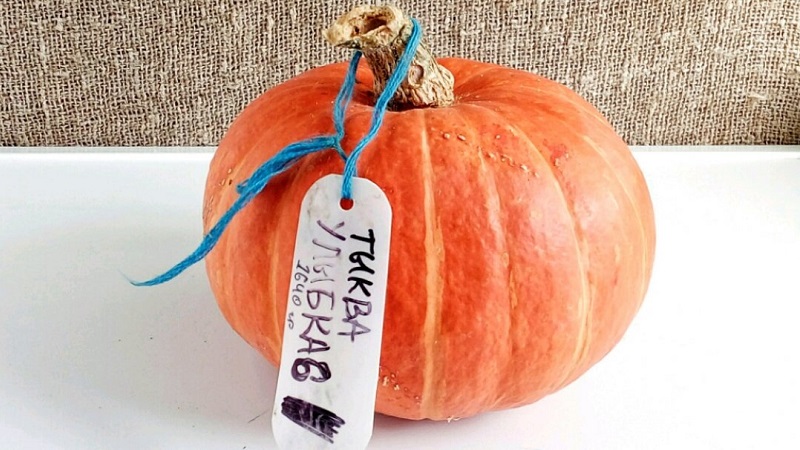
Description of the variety Zorka
The Dawn pumpkin has a rounded flattened shape. The weight of one fruit reaches 4.2 kg. The surface is segmented, with a pattern in the form of light gray stripes and orange spots. The peel is thin, bent, and light green when cut.
The pulp is dense, slightly juicy, rough, has a bright orange color. The seed nest is small, bright yellow. Seeds are medium in size, yellow-brown in color. The fruit has a sweet taste. The large-fruited pumpkin Zorka belongs to the mid-early varieties.
Parisian gold
The large-fruited Parisian Golden Pumpkin is a fast growing variety with fairly large fruits. The growing season is 105 to 115 days. This powerful plant has long lashes.
Pumpkins weigh 15-25 kg, often grow up to 40-60 kg. The bark is thin, the flesh is thick, juicy, yellow. The taste does not deteriorate during storage. The fruits are used for all types of processing. Stored until March-April.
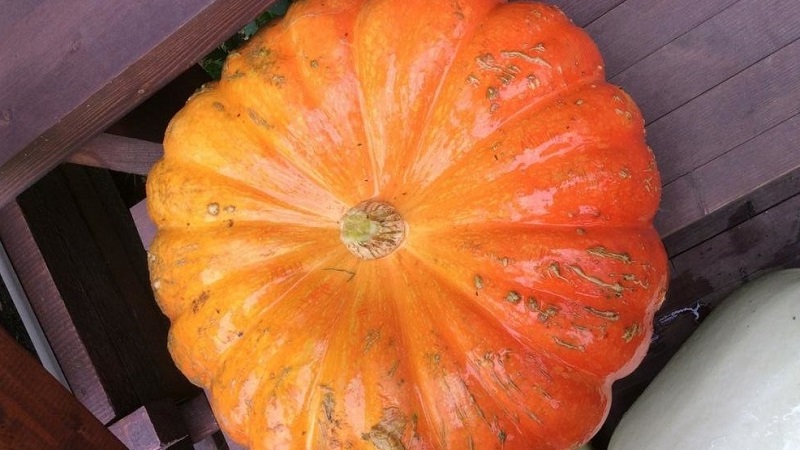
Baby
This is an early ripening variety. From germination to ripening, 80-90 days pass. Ovary formation occurs as early as 35-40 days after germination. The plant is compact, bush type. The fruits are dark gray with a brown tint, the shape is flattened, the mass of one vegetable reaches 2-3 kg.
The pulp is of medium density and juiciness, crispy, sugary, orange. Sugar Baby has excellent taste, it has a high carotene content. The variety is grown both by seedlings and direct sowing in open ground. 3.2 kg of the crop is harvested from 1 square meter.
Titanium
The large-fruited Titan pumpkin reaches large sizes. A vegetable can gain weight up to 100 kg. Medium late pumpkin bears fruit on 135-140 days. For Titan, a large area is required, since the plant is distinguished by strong growth and long lashes.
It is recommended to plant in a 2x2 m pattern. Large pumpkins of this variety are rounded and bright orange in color. The pulp of the vegetable is slightly darker than the peel, contains few seeds, and tastes good. Other varieties have tastier flesh, so Titan is grown by those who want a large vegetable.

Matryoshka
This is an early ripe variety of large-fruited pumpkin - 80-85 days pass from germination to harvesting. Great for growing in small areas. Shrub plant is very compact, grows intensively and bears fruit in a small area. The smooth fruit is flat and orange in color.
The mass of one vegetable ranges from 1.8-2.4 kg. The bark is thin and flexible. The pulp is juicy, sweet, rich yellow, uniform consistency. Pupa Matryoshka shows good resistance to powdery mildew and drought. The vegetable contains a large amount of vitamins, in particular - carotene, making it suitable for children and diet food.
Sweetheart
The fruits of this plant ripen early, 85-95 days from germination. Suitable for cultivation in hot regions. It is a drought-resistant variety. The vegetable is round in shape, the surface is segmented, smooth. One pumpkin can weigh between 1.5 and 6 kg.
The skin color is dark green. The pulp is orange, sweet, the amount of juice is medium. The fruits tolerate transportation well and are stored for a long time (up to 9 months). The vegetable is used for making puree and juice. For sowing Slastena, a site with a large amount of nutrients in the soil is recommended.
Barn
Pumpkin Barn is a highly productive mid-season variety. Semi-bush plant. Fruit color - dark green, flat-round shape. The mass of one vegetable is 2-4 kg. The variety has a high carotene content and a long shelf life. The pulp is juicy, bright orange.
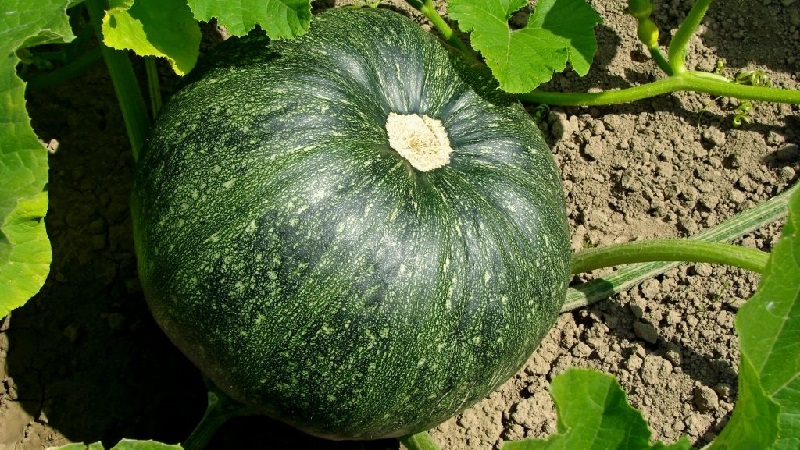
Winter sweet
A late-ripening large-fruited variety with pleasant-tasting fruits. The ripening period is 110-140 days from the moment of germination. Large-leaved bush with long lashes. Fruits of different sizes, flattened shape, grayish shade with spots. They are thin, with dense orange flesh.
The yield of the variety is about 20 kg per sq. m. The variety is not afraid of a lack of moisture, is suitable for growing in cold regions, and has excellent taste.
Marble
Variety Marble with an average maturity of fruits, intended for planting in warm regions of Russia. The first crop is harvested 4 months after the first shoots appear. The bushes form green-gray flattened round pumpkins weighing 6-10 kg. Their flesh is loose, orange in color, and has a pleasant taste.
After ripening, the peel becomes green-gray. The variety is suitable for long distance transportation. The fruits do not crack or rot. At low temperatures, pumpkins can be stored for a long time - about 1 year.
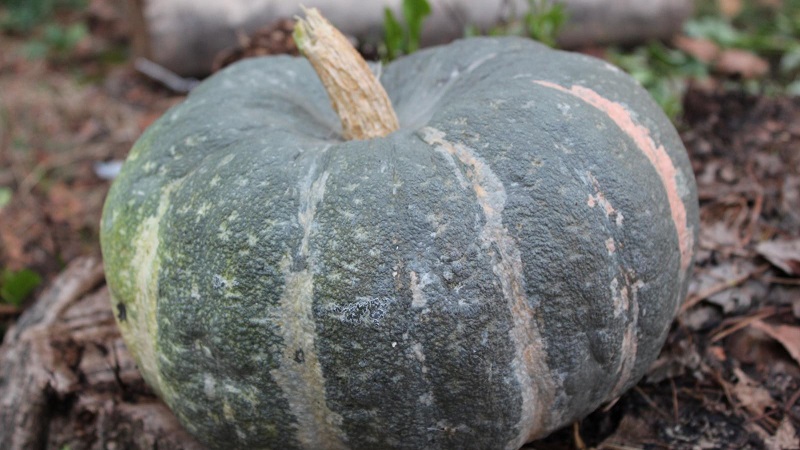
Kherson
This pumpkin is known to some as a large-fruited blue with gray spots. The plant is climbing, medium-late ripening, with flat fruits. The mass of one vegetable is 4-6 kg. The pulp is orange, crispy, sweet, juicy. The variety is thermophilic, drought-resistant. Stored well.
Children's gourmet
This is a mid-season hybrid of a table purpose. From germination to harvesting, 110-115 days pass. The climbing plant produces many portioned fruits. A flat-round vegetable gains weight up to 3 kg. Orange pumpkins have dark green stripes. The pulp is firm, juicy, sweet, greenish-orange in color. One plant can harvest 8-10 kg.
Did you know? In ancient China, large-fruited pumpkin was considered the queen of vegetables. It was grown in the palace of the emperor. As a sign of special mercy, the emperor gave the largest fruits to his entourage.
Features of agricultural technology of large-fruited pumpkins
Pumpkin, like all vegetables, needs a lot of light, heat and moisture. Therefore, the site for the plant should be chosen sunny and protected from the wind.
On a note. A suitable place would be a garden bed on the south side of the house or outbuildings.
Almost all large-fruited pumpkins are climbing, therefore, when planting a plant, there should be supports nearby (special trellises, a hedge or a wall). A rich crop can only be grown in loose, nutritious soil. Heavy and acidic soil is not suitable for pumpkin.
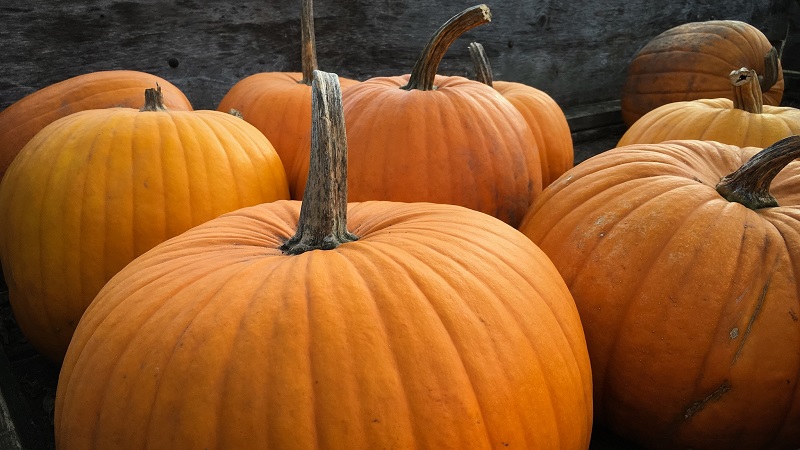
Seed preparation and seedling growing
In order for the pumpkin to fully ripen in difficult climatic conditions, vegetable growers grow the plant through seedlings.
The largest and highest quality seeds are selected for sowing. The best way to prepare seed material - germination.
To do this, 2-3 days before sowing, the seeds are placed for two hours in warm water (45-50 ° C), then they are wrapped in a damp cloth and kept at room temperature until they hatch. Seed soaking is a must. This procedure promotes the rapid emergence of seedlings and protects the seeds from pests.
After planting the seeds, seedlings will appear on about the fourth day. The air temperature during the week should be within + 18 ... + 25 ° C, then it is reduced to + 15 ... + 18 ° C. This is done so that the seedlings do not stretch out and grow strong.
Seedlings are watered regularly, but in moderation. Stagnant water is harmful to the roots. After two weeks, top dressing is carried out. To do this, the mullein is mixed with water in a ratio of 1:10 and each plant is watered with 100 ml of nutrient solution. Fertilizer is applied after moistening the seedlings. If there is no mullein, nitrophoska is used as a top dressing, following the instructions.
Planting, care and cultivation
The planting is carried out according to the scheme, given that such a pumpkin needs freedom. At least 1 m is usually left between plants, but for some varieties - up to 2 m.
During the season, the culture is fed twice:
- for the first time - 10 days after planting the seedlings at a permanent place of growth;
- the following fertilizers are applied during the formation of the lashes.
To do this, use bird droppings (1:20), diluted mullein (1:10), infusion of wood ash. Also, a good complex fertilizer will be the drug "Nitrofoska". They are fed pumpkin both the first time and the second.
Important! Fertilizers are applied in the form of water infusions.
During the entire growing season, the vegetable is watered abundantly, especially during flowering and fruit setting. The water should be kept warm. After moistening, the soil is gently loosened, and at the same time gets rid of weeds. For better pumpkin growth, mulching is carried out (cover the ground with straw, bark, and a special cloth).
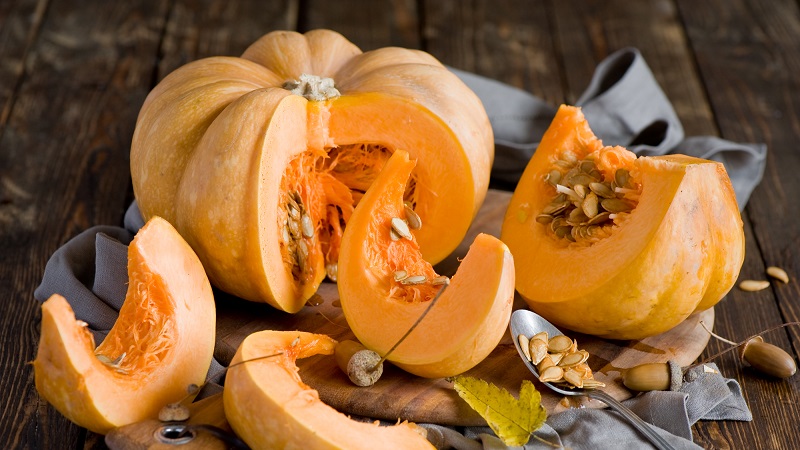
Forming pumpkin bushes
The pumpkin grows pretty quickly at the beginning. Since this is a spreading plant, the territorial boundaries of the culture must be observed. For this, pumpkin bushes are formed during the opening of the whips.
Before the first inflorescences appear, it is necessary to pinch the bud at the top of the shoot.This is done to allow lateral shoots to grow.
Important! You should also remove young shoots growing "in the axils", reaching 5-7 cm.
Such measures prevent the expenditure of the vital forces of the plant on extra leaves and whips, directing them to the formation and cultivation of pumpkin fruits.
One ovary should be left on each branch.
Pollination
Usually this culture is pollinated by insects, but if there are no bees or bumblebees on the site (in rains or prolonged heat), the plant will have to be pollinated on its own. To do this, apply the stamen of the male flower to the pistil of the female. The procedure is carried out in the morning, trying not to miss the moment of opening the flowers.
Need to know! Female pumpkin flowers have a slight thickening - the fruit, in male flowers, immediately after the flower there is a stem.
If pollination does not occur, the fruits will not form.
Reviews of summer residents
Svetlana, Ivanovo: “I wanted to diversify my garden and try something new. In the store I liked the “Smile” variety, I saw a ruddy pumpkin in the photo. I was completely satisfied with the result! Not bothering much, I got a gorgeous harvest - 6-7 pumpkins per bush. She took care of the pumpkin, as well as for other plants - she regularly watered and weeded. I also liked the taste and the fact that these vegetables are stored for a long time under my conditions: in the apartment on the closet. I plan to plant it again by spring. "
Semyon, Rostov: “I planted the Titan variety last summer. It began to grow, the lashes were so long that they had to be twisted around the root. The first ovaries appeared in the second half of summer, about 6 pieces, but I left only one. The fruits are very beautiful, bright orange in color. I planted this variety for testing. The fruits are very pleasant to the taste, without the characteristic pumpkin smell, which is sometimes repulsive. You can eat this pumpkin even raw: the pulp is not hard, sweetish. The wife made juice out of it, and cut the rest into candied fruits. I will plant more next season. "
Valentina, Perm: “I took seeds of the“ Malyshka ”variety. The bag contained 6 seeds and detailed instructions on the back. I liked the fact that I got an excellent harvest without much hassle. Neat bushes, without long shoots, which is of great importance to me - I have a small plot. The only thing I did was to fill the seeds with ground pepper before planting in the ground, as ants love them very much. The pumpkins have grown large - each no less than 2 kg. "

Conclusion
Large-fruited pumpkin is a rather unpretentious vegetable to care for, it requires a minimum of effort. The culture grows well in temperate and warm climates. With minimal requirements for the maintenance and feeding of the plant, you can even grow a vegetable weighing 100 kg.
You will learn more detailed information about growing large-fruited pumpkin from the video: